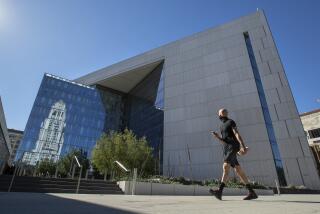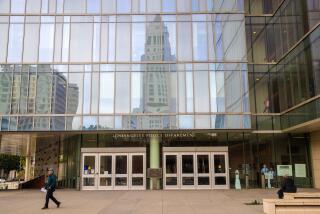Computer program could point police to gang-crime suspects
- Share via
A team of UCLA researchers has delved again into the world of crime fighting, this time developing a computer program capable of pointing police to potential suspects when feuds between rival gangs erupt into violence.
The work is the latest contribution in the fast-emerging field of predictive policing — a broad area of study rooted in the notion that it is possible, through sophisticated computer analysis of information about previous crimes, to predict where and when crimes will occur or, in this case, to calculate the probability a certain gang committed a crime.
Some of the most ambitious work is being done at UCLA, where researchers are concentrating largely on the ways criminals behave in urban settings.
In the recent research, mathematicians devised an algorithm to crunch information the Los Angeles Police Department collected on more than 1,000 gang-related crimes and suspected gang crimes in the LAPD’s Hollenbeck Division — an area east of downtown L.A. that is home to more than two dozen active gangs. Often, a perceived or real affront by one gang to another can set off a spiral of retaliatory violence.
The goal was to bring some mathematical order to this murky, shifting landscape in Hollenbeck, where rivalries and alliances between groups are difficult to track.
The computer model the researchers built sifted through a decade’s worth of crime data in search of patterns and relationships between gangs undetectable to a person. From that analysis, the program was designed to identify which gangs were most likely involved in particular crimes.
To test it, the researchers created an imaginary set of crime data that closely mirrored the shootings, assaults and other gang-on-gang crimes that occurred in Hollenbeck. They then removed pieces of important information, such as the name of one or both of the involved gangs, and tested whether the computer algorithm could come up with the missing data.
About 80% of the time, the computer calculations were able to identify the three gangs most likely to have committed a crime against a rival, the researchers said.
“That narrows it down quite a bit,” said Martin Short, co-author of the study, in an announcement released by UCLA. It is “significantly better than chance,” he said.
Short and the others also found that the algorithm identified the correct gang, rather than just the top three, half of the time. Simple chance produced the right gang only 17% of the time.
“If police believe a crime might have been committed by one of seven or eight rival gangs, our method would look at recent historical events in the area and compute probabilities as to which of these gangs are most likely to have committed crime,” said the study’s senior author, Andrea Bertozzi, director of applied mathematics at UCLA.
Bertozzi said the same mathematics used in the gang rivalry study can be applied in other areas of law enforcement and other industries. Identifying and tracking down computer hackers is one possibility, she suggested, as is trying to determine members in a terrorist cell.
Put simply, wherever there are distinct events that occur in a certain time frame and involve members of a distinct group, it is possible to use the mathematics to come up with the probability that a certain member of the group is involved. With a terrorist cell, for example, law enforcement agents might be trying to monitor the cell’s email exchanges, but not know the names of the senders and recipients of all the messages. The algorithm could potentially be used to fill in the blanks.
The team of researchers has been picking apart other types of crime data as well. They have built a mathematical model that allows them to identify crime hot spots and predict how those areas would respond to an influx of police officers. And a Times article last year profiled their efforts to devise another predictive algorithm — one that eventually could enable police to anticipate, and possibly prevent, many types of crimes.
The LAPD has positioned itself at the center of the quickly emerging field of predictive policing, sharing crime data with the UCLA researchers and seeking federal grants to run pilot programs within the department. Bertozzi said it was not immediately clear how the LAPD would put the gang algorithm to use. The LAPD official who oversees the department’s predictive policing efforts could not be reached for comment.
The latest research can be found on the website of the mathematical journal Inverse Problems, which will publish the findings in a future print edition, the university said.
More to Read
Sign up for Essential California
The most important California stories and recommendations in your inbox every morning.
You may occasionally receive promotional content from the Los Angeles Times.











